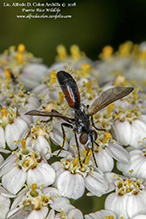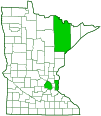Tachinid fly
(Cylindromyia interrupta)
Conservation • Description • Habitat • Ecology • Distribution • Taxonomy
Conservation Status |
|||
| IUCN Red List |
|
||
| NatureServe |
|
||
| Minnesota |
|
||
Description |
Cylindromyia interrupta is a small tachinid fly. It occurs in northern Europe, in Scandinavia, and across North America. Adults are slender, wasp-like, and ¼″ to 5 ⁄16″ (6 to 8 mm) long. There are two large compound eyes at the side of the head and three small simple eyes (ocelli) in a triangle at the top of the head. The compound eyes are brown. They do not meet at the top of the head in either sex. The antennae are black, moderately long, and have three segments. The second segment has a longitudinal groove (suture) on top. The third segment has a short, forward-pointed bristle (arista) on the upper side. The arista is bare, not feather-like (plumose). The protruding mouthpart (proboscis) is slender but is not much elongated. The thorax is narrow, barely as wide as the head. It is mostly black but appears frosty white (pruinose) in the shoulder (humeral) area. The plate between the wings (scutellum) is colored the same as the thorax. It has only one pair of long, black, bristles at the rear margin. The abdomen is narrow, elongated, and black, and is armed with long, stiff, black bristles. The first abdominal segment is very small and is not visible from above. On the second and third segments there is a row of bristles on the upper middle and a row on each side. On the fourth and fifth segments there is a row at the rear margin. There is a white, very narrow band at the base of the second and third segments. There is also a broad reddish band that wraps around the the bottom and sides of the abdomen but is interrupted on the top, leaving a broad black stripe. It is variable in size, usually extending over most of the second segment and about half of the third. As with all flies, there is only one pair of wings, the hind wings being reduced to small, knob-like structures (halteres) that are used for balance in flight. The wings are narrow and smoky brown. At the base of each wing there are two small, rounded lobes (calypters) that cover the halteres. The calypters are well-developed and bright white. The legs are long, stout, and entirely black. |
Size |
Total length: ¼″ to 5 ⁄16″ (6 to 8 mm) Wingspan: ½″ (12 mm) |
Similar Species |
Habitat |
Open, dry, weedy areas |
Ecology |
Season |
May to August |
Behavior |
|
Life Cycle |
|
Larva Food |
Stink bugs (Pentatomidae), short-horned grasshoppers (Acrididae), and moths |
Adult Food |
Nectar and pollen of flowers in the family Apiaceae (carrot). |
Distribution |
||
|
Sources |
|
| 8/29/2025 | ||
Occurrence |
||
Widespread but not common in North America |
||
Taxonomy |
|
Order |
|
Suborder |
Brachycera |
Infraorder |
Cyclorrhapha |
Zoosection |
Schizophora |
Zoosubsection |
|
Superfamily |
Oestroidea (Bot Flies, Blow Flies, and Allies) |
Family |
|
Subfamily |
Phasiinae |
Tribe |
Cylindromyiini |
Genus |
|
Subgenus |
Neocyptera |
Subordinate Taxa |
|
|
|
Synonyms |
|
Cylindromyia boscii Cylindromyia dosiades lobata Ocyptera dosiades Ocyptera interrupta Ocyptera setulosa |
|
Common Names |
|
This species has no common name. The common name for the family Tachinidae is tachinid flies, and it is applied here for convenience. |
|
Glossary
Arista
A large bristle on the upper side of the third segment of the antenna of a fly. Plural: aristae.
Calypter
On flies: one of two small membranous lobes at the base of the forewing that covers the haltere.
Halteres
In flies: a pair of knob-like structures on the thorax representing hind wings that are used for balance.
Ocellus
Simple eye; an eye with a single lens. Plural: ocelli.
Proboscis
The tube-like protruding mouthpart(s) of a sucking insect.
Scutellum
The exoskeletal plate covering the rearward (posterior) part of the middle segment of the thorax in some insects. In Coleoptera, Hemiptera, and Homoptera, the dorsal, often triangular plate behind the pronotum and between the bases of the front wings. In Diptera, the exoskeletal plate between the abdomen and the thorax.
Visitor Photos |
Share your photo of this insect. |
||
This button not working for you? |
||
Alfredo Colon |
 |
MinnesotaSeasons.com Photos |
|

Slideshows |
|

Visitor Videos |
Share your video of this insect. |
||
This button not working for you? |
||
|
Other Videos |
|

|
Created: Created: 2/4/2019 Last Updated: © MinnesotaSeasons.com. All rights reserved. |


